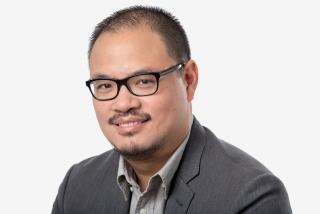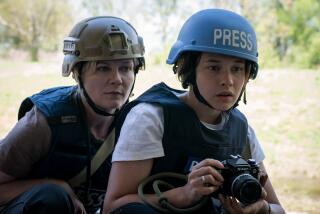John Hersey; Won Pulitzer Prize for ‘A Bell for Adano’
- Share via
John Hersey, a World War II correspondent who graphically described the horrors of the world’s first atomic bomb attack and won the Pulitzer Prize for his war-based novel “A Bell for Adano” died Wednesday. He was 78.
The author, who suffered a stroke a year ago and also had cancer of the colon and liver, died at 2:45 a.m. in Key West, Fla., with his family at his side, said his wife, Barbara.
Hersey first wrote his nonfiction account of “Hiroshima” as an entire issue of the New Yorker magazine published Aug. 31, 1946. The essay, which described the realities of the grim dawning of the atomic age, searingly traced the experiences of six Japanese survivors of the American bombing of Hiroshima on Aug. 6, 1945. The account was soon published as a book, and it was also made into a film.
Hersey covered the war for Time magazine and turned the experience of American soldiers occupying an Italian village into his 1944 Pulitzer Prize-winning novel. The book, describing the attempts of a well-meaning Italian-American officer named Maj. Joppolo to rebuild the occupied town, later became a play and in 1945 a film by 20th Century Fox.
“John Hersey’s writing about the moral problems in World War II was of the highest quality,” author James Michener said.
As a correspondent and novelist, Hersey felt strongly that fiction could be used to advantage in depicting real life.
“Fiction is a clarifying agent. It makes truth plausible,” he wrote for the Atlantic Monthly in 1949. “Among all the means of communication now available, imaginative literature comes closer than any other to being able to give an impression of the truth.”
His other books based on World War II were “Men on Bataan” in 1942 and “Into the Valley” in 1943.
Later concentrating on subjects ranging from the U.S. presidency (particularly the administrations of Harry S. Truman and Gerald R. Ford) to the Stradivarius violin, Hersey penned more than 20 books. Among them were “The Wall” in 1950 about Jewish victims of the Holocaust, which was made into a CBS television movie in 1982; “The War Lover” in 1959, which became a movie by Columbia in 1962; “White Lotus” in 1965; “The Algiers Motel Incident” in 1968; “The President” in 1975; “Aspects of the Presidency” in 1980; “Fling and Other Stories” in 1990, and his final novel, about the violin, “Antonietta,” in 1991.
Born June 17, 1914, in Tientsin, China, as the son of American missionary parents, Hersey moved to the United States at age 10.
“I was born a foreigner,” he said in a rare interview in 1985. “I was born in China, and I think in some ways I have been an outsider in America because of that.”
Hersey earned a bachelor’s degree at Yale University in 1936 and spent a summer as secretary and driver for writer Sinclair Lewis.
He later wrote a profile of Lewis, along with portraits of Lillian Hellman and James Agee, in a 1989 collection of essays titled “Life Sketches.” In a rare note for a writer of such stature, Hersey publicly apologized for similarities in the essay on Agee--first published in the New Yorker on July 18, 1988--to passages from a biography of Agee written by Laurence Bergreen in 1984.
Hersey worked for Time from 1937 to 1944 and then switched to its companion Life magazine to finish out the war coverage. He wrote for the New Yorker immediately after the war. Many of his books continued to reflect his war-years view of America’s presence in foreign countries.
The prolific novelist lectured for 18 years at Yale and at Massachusetts Institute of Technology. He was also active in Democratic politics.
“He was an extraordinarily versatile writer and the world was his subject,” Judith Jones, Hersey’s editor at Albert A. Knopf Publishing, said on learning of his death.
“He believed that a writer’s job was to write and not spend time doing publicity,” she said. “He was a very private person.”
In addition to the Pulitzer, Hersey’s books garnered the Anisfield-Wolf Award and the Daroff Memorial Fiction Award from the Jewish Book Council of America in 1950, the Sidney Hillman Foundation Award in 1951, Yale’s Howland Medal in 1952, the National Assn. of Independent Schools Award in 1957, the Tuition Plan Award in 1961 and the Sarah Josepha Hale Award in 1963.
Hersey married twice. With his first wife, Frances Ann Cannon, whom he married in 1940 and divorced in 1958, he had three sons, Martin, John and Baird, and one daughter, Ann. He married his second wife, Barbara Kaufman, in 1958, and with her had one daughter, Brook. Survivors also include six grandchildren.
More to Read
Sign up for our Book Club newsletter
Get the latest news, events and more from the Los Angeles Times Book Club, and help us get L.A. reading and talking.
You may occasionally receive promotional content from the Los Angeles Times.










